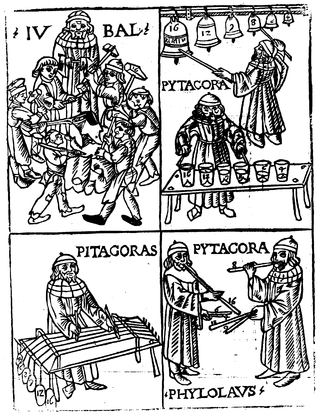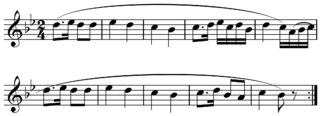Sources
- Nattiez, Jean-Jacques (1990). Music and Discourse: Toward a Semiology of Music (Musicologie générale et sémiologue, 1987). Translated by Carolyn Abbate (1990). ISBN 0-691-02714-5.
Esthesic (UK aesthesic) and poietic are terms used in semiotics, the study of signs, to describe perceptive and productive levels, processes, and analyses of symbolic forms. The corresponding terms for the processes are esthesis and poiesis .
Like 'emic' and 'etic', both words appear to be derived from a suffix, -poietic (from Greek : ποιητικός "creative") meaning productive or formative and -esthesic (from αἴσθησις "sense") being receptive or perceptive, in relation to the neutral level. The neutral level is the "trace" left behind, the physical or material creation of esthesic and poietic processes.
Thus, "a symbolic form... is not some 'intermediary' in a process of 'communication' that transmits the meaning intended by the author to the audience; it is instead the result of a complex process of creation (the poietic process) that has to do with the form as well as the content of the work; it is also the point of departure for a complex process of reception (the esthesic process) that reconstructs a 'message.'" (Nattiez 1990, p. 17)
Nattiez's diagram, following Jean Molino:
| Poietic Process | Esthesic Process | |||
| "Producer" | → | Trace | ← | Receiver |
"Esthesic" also refers to the mental perception of any body part. [1] "-poesis"/"-poetics" also refers to production. [2] [3]
A definition of music endeavors to give an accurate and concise explanation of music's basic attributes or essential nature and it involves a process of defining what is meant by the term music. Many authorities have suggested definitions, but defining music turns out to be more difficult than might first be imagined, and there is ongoing debate. A number of explanations start with the notion of music as organized sound, but they also highlight that this is perhaps too broad a definition and cite examples of organized sound that are not defined as music, such as human speech and sounds found in both natural and industrial environments. The problem of defining music is further complicated by the influence of culture in music cognition.
Neutral or neutrality may refer to:
Semiotics is the systematic study of sign processes (semiosis) and meaning making. Semiosis is any activity, conduct, or process that involves signs, where a sign is defined as anything that communicates something, usually called a meaning, to the sign's interpreter. The meaning can be intentional, such as a word uttered with a specific meaning; or unintentional, such as a symptom being a sign of a particular medical condition. Signs can also communicate feelings and may communicate internally or through any of the senses: visual, auditory, tactile, olfactory, or gustatory (taste). Contemporary semiotics is a branch of science that studies meaning-making and various types of knowledge.

A symbol is a mark, sign, or word that indicates, signifies, or is understood as representing an idea, object, or relationship. Symbols allow people to go beyond what is known or seen by creating linkages between otherwise very different concepts and experiences. All communication is achieved through the use of symbols. Symbols take the form of words, sounds, gestures, ideas, or visual images and are used to convey other ideas and beliefs. For example, a red octagon is a common symbol for "STOP"; on maps, blue lines often represent rivers; and a red rose often symbolizes love and compassion. Numerals are symbols for numbers; letters of an alphabet may be symbols for certain phonemes; and personal names are symbols representing individuals. The variable 'x', in a mathematical equation, may symbolize the position of a particle in space.

Music theory is the study of the practices and possibilities of music. The Oxford Companion to Music describes three interrelated uses of the term "music theory": The first is the "rudiments", that are needed to understand music notation ; the second is learning scholars' views on music from antiquity to the present; the third is a sub-topic of musicology that "seeks to define processes and general principles in music". The musicological approach to theory differs from music analysis "in that it takes as its starting-point not the individual work or performance but the fundamental materials from which it is built."

Musical analysis is the study of musical structure in either compositions or performances. According to music theorist Ian Bent, music analysis "is the means of answering directly the question 'How does it work?'". The method employed to answer this question, and indeed exactly what is meant by the question, differs from analyst to analyst, and according to the purpose of the analysis. According to Bent, "its emergence as an approach and method can be traced back to the 1750s. However it existed as a scholarly tool, albeit an auxiliary one, from the Middle Ages onwards."

In music, a motif(pronunciation) (help·info) IPA: (/moʊˈtiːf/) is a short musical idea, a salient recurring figure, musical fragment or succession of notes that has some special importance in or is characteristic of a composition. The motif is the smallest structural unit possessing thematic identity.
In semiotics, a sign is anything that communicates a meaning that is not the sign itself to the interpreter of the sign. The meaning can be intentional, as when a word is uttered with a specific meaning, or unintentional, as when a symptom is taken as a sign of a particular medical condition. Signs can communicate through any of the senses, visual, auditory, tactile, olfactory, or taste.

In music theory, a phrase is a unit of musical meter that has a complete musical sense of its own, built from figures, motifs, and cells, and combining to form melodies, periods and larger sections.
A phrase is a substantial musical thought, which ends with a musical punctuation called a cadence. Phrases are created in music through an interaction of melody, harmony, and rhythm.

Music can be analysed by considering a variety of its elements, or parts, individually or together. A commonly used list of the main elements includes pitch, timbre, texture, volume, duration, and form. The elements of music may be compared to the elements of art or design.

Jean-Jacques Nattiez is a musical semiologist or semiotician and professor of musicology at the Université de Montréal. He studied semiology with Georges Mounin and Jean Molino and music semiology (doctoral) with Nicolas Ruwet.
In semiotics the neutral level of a sign is the "trace" left behind; the physical or material creation or remains of esthesic and poietic processes, levels, and analyses of symbolic forms. A part of all signs according to a tri-partitional definition, it corresponds to Saussure's "sound-image".
"Cognitive Constraints on Compositional Systems" is an essay by Fred Lerdahl that cites Pierre Boulez's Le Marteau sans maître (1955) as an example of "a huge gap between compositional system and cognized result," though he "could have illustrated just as well with works by Milton Babbitt, Elliott Carter, Luigi Nono, Karlheinz Stockhausen, or Iannis Xenakis". To explain this gap, and in hopes of bridging it, Lerdahl proposes the concept of a musical grammar, "a limited set of rules that can generate indefinitely large sets of musical events and/or their structural descriptions". He divides this further into compositional grammar and listening grammar, the latter being one "more or less unconsciously employed by auditors, that generates mental representations of the music". He divides the former into natural and artificial compositional grammars. While the two have historically been fruitfully mixed, a natural grammar arises spontaneously in a culture while an artificial one is a conscious invention of an individual or group in a culture; the gap can arise only between listening grammar and artificial grammars. To begin to understand the listening grammar, Lerdahl and Ray Jackendoff created a theory of musical cognition, A Generative Theory of Tonal Music. That theory is outlined in the essay.
Music semiology (semiotics) is the study of signs as they pertain to music on a variety of levels.
In music cognition and musical analysis, the study of melodic expectation considers the engagement of the brain's predictive mechanisms in response to music. For example, if the ascending musical partial octave "do-re-mi-fa-sol-la-ti-..." is heard, listeners familiar with Western music will have a strong expectation to hear or provide one more note, "do", to complete the octave.
In semiotics, poiesis is "the activity in which a person brings something into being that did not exist before."
The term seriation [mise en série] was proposed for use in semiotics by Jean Molino and derived from classical philology. Seriation "invokes the idea that any investigator, in order to assign some plausible meaning to a given phenomenon, must interpret it within a series of comparable phenomena." One cannot interpret what philology calls a hapax; that is, an isolated phenomenon. Art historian Erwin Panofsky has explained the situation in very clear terms:
Telematic art is a descriptive of art projects using computer-mediated telecommunications networks as their medium. Telematic art challenges the traditional relationship between active viewing subjects and passive art objects by creating interactive, behavioural contexts for remote aesthetic encounters. Telematics was first coined by Simon Nora and Alain Minc in The Computerization of Society. Roy Ascott sees the telematic art form as the transformation of the viewer into an active participator of creating the artwork which remains in process throughout its duration. Ascott has been at the forefront of the theory and practice of telematic art since 1978 when he went online for the first time, organizing different collaborative online projects.
The Poietic Generator is a social-network game designed by Olivier Auber in 1986, and developed from 1987 under the label free art thanks to many contributors. The game takes place within a two-dimensional matrix in the tradition of board games and its principle is similar to both Conway's Game of Life and the surrealists' exquisite corpse.
Gordon music-learning theory is a model for music education based on Edwin Gordon's research on musical aptitude and achievement in the greater field of music learning theory. The theory is an explanation of music learning, based on audiation and students' individual musical differences. The theory takes into account the concepts of discrimination and inference learning in terms of tonal, rhythmic, and harmonic patterns.